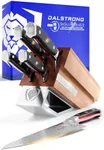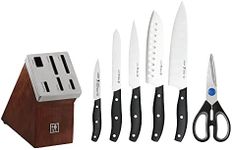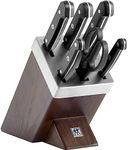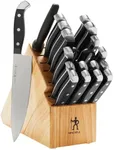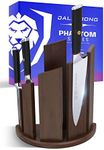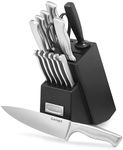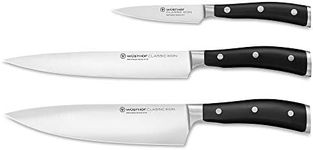Buying Guide for the Best Kitchen Knife Sets
Choosing the right kitchen knife set can make cooking easier, safer, and more enjoyable. A good set should cover all your basic cutting needs, feel comfortable in your hand, and last for years with proper care. When shopping, focus on the types of knives included, the quality of the materials, and how the set matches your cooking habits. Understanding the key features will help you find a set that fits your kitchen and your style of cooking.Types of Knives IncludedThis refers to the variety of knives that come in the set, such as chef’s knife, paring knife, bread knife, utility knife, and sometimes specialty knives. The importance lies in having the right tool for each kitchen task. Sets with more knives offer versatility, but you should consider which knives you actually use. If you cook a wide range of dishes, a larger set may be helpful. If you mostly prepare simple meals, a basic set with a chef’s knife, paring knife, and bread knife might be enough.
Blade MaterialBlade material affects sharpness, durability, and maintenance. Common materials include stainless steel, high-carbon steel, and ceramic. Stainless steel is resistant to rust and easy to maintain, making it good for everyday use. High-carbon steel holds a sharp edge longer but may require more care to prevent rust. Ceramic blades are very sharp and lightweight but can chip if dropped. Choose a material based on how much maintenance you’re willing to do and how often you use your knives.
Handle Comfort and MaterialThe handle should feel comfortable and secure in your hand, as this affects safety and ease of use. Handles can be made from wood, plastic, or composite materials. Wood handles offer a classic look but may need more care to avoid damage from moisture. Plastic and composite handles are durable and easy to clean. If you have smaller or larger hands, try to find handles that fit your grip well. Comfort is personal, so consider how the handle feels during use.
Balance and WeightBalance refers to how the weight is distributed between the blade and the handle. A well-balanced knife feels stable and easy to control, reducing fatigue during long cooking sessions. Weight preferences vary: heavier knives can make cutting easier by adding force, while lighter knives offer more agility. Think about what feels more comfortable for you and the types of foods you usually prepare. If possible, try holding different knives to see what balance and weight suit you best.
Storage OptionsKnife sets often come with a storage block, magnetic strip, or protective sheaths. Storage is important for safety and keeping blades sharp. A block keeps knives organized and within reach, while a magnetic strip saves counter space. Sheaths are good for small kitchens or if you store knives in a drawer. Consider your kitchen layout and how much space you have when choosing a set with the right storage solution.
Ease of MaintenanceSome knives require more care than others. For example, high-carbon steel may need regular oiling to prevent rust, while stainless steel is more forgiving. Dishwasher-safe knives are convenient but may dull faster over time. If you prefer low-maintenance tools, look for knives that are easy to clean and resistant to staining or rust. Think about how much time you want to spend on upkeep when making your choice.




